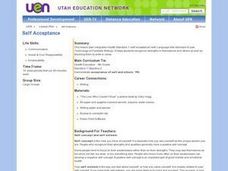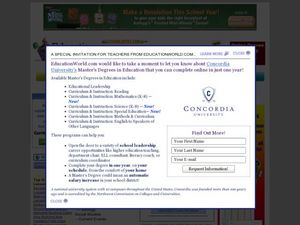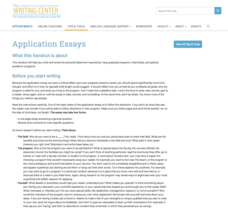Curated OER
Crossing the Finish Line: Writing a Job Acceptance Letter
Each paragraph of your job acceptance letter is described for you here. Find out why to write one, how to write one, and what you need to included. Example of tone, purpose, and structure are included alongside the provided information.
K12 Reader
Acceptance Speech
"I'd like to thank the members of the academy . . ." Kids craft an acceptance speech in which they identify what the award is for, their qualifications, and how they feel about being the recipient.
Literacy Design Collaborative
Elie Wiesel's Acceptance Speech Analysis
Elie Wiesel's Nobel Prize Acceptance speech provides young historians with an opportunity to demonstrate their ability to use evidence from the speech. They work together to analyze how Wiesel uses rhetorical devices and syntax to...
Museum of Disability
Don't Laugh at Me
You can prevent bullying in your classroom by addressing kindness, empathy, and acceptance with your littlest learners early on. After reading Don't Laugh at Me by Steve Seskin and Allen Shamblin, kids discuss the ways that words...
Museum of Disability
Don't Call Me Special
Introduce young learners to the idea of disabilities and making friends with children who are different than they are. Using Don't Call Me Special - A First Look at Disability by Pat Thomas, learners are guided through the new...
Curated OER
How Are We Different?
Students discuss the differences between boys and girls. In this acceptance instructional activity, students view pictures of boys and girls and use a Venn Diagram to chart their differences. Students discuss boy activities...
Museum of Disability
Stand Tall, Molly Lou Melon
Help to create the next generation of friends with a lesson about accepting people who are different. As kids read Stand Tall, Molly Lou Melon, they answer a series of discussion questions and activities about making friends...
Curated OER
Arthur's Nose
Students read a story and complete a story map. In this diversity and acceptance instructional activity, students read Arthur's Nose, make a story map, research Aardvarks, complete a Venn Diagram comparing Arthur's nose to other...
Polk Bros Foundation
Harold Washington's Acceptance Speech - April 12th, 1983
Harold Washington forged a coalition of voters and won the Chicago mayoral election of 1983. In doing so he became the first black mayor of that racially and ethnically divided city. Excerpts from his speech are included in a worksheet...
Museum of Disability
Taking Down Syndrome to School
Teach your class about the ways they can befriend and understand people who are different from them with a reading comprehension lesson. As youngsters read Taking Down Syndrome to School by Jenna Glatzer, they answer a...
Curated OER
Self-acceptance
Students assess the importance of acceptance of self and others via the development of self-worth and the looking for the good in others not the bad. They explore the task of looking at the world through the eyes of others. In addition,...
National Endowment for the Humanities
García Márquez’s Nobel Prize Speech: “The Solitude of Latin America”
To conclude a study of One Hundred Years of Solitude, class members analyze Gabriel Garcia Marquez's Nobel Prize in Literature acceptance speech. After a whole-class discussion of the main ideas in the speech, individuals draft a...
Curated OER
No Name Calling
Students use literacy skills to gain information about tolerance. In these lessons on acceptance, student read stories, answer questions, survey students, and plan a citizenship week to encourage participation in a No Name Calling week.
Curated OER
"Little" Brothers Share Big Bond
Students listen to the story Little Brothers Share Big Bond and answer comprehension questions. In this instructional activity on acceptance, students use various areas of reading (vocabulary, fluency, comprehension) to promote...
Museum of Disability
Rolling Along
Kindness and empathy can be as important as reading comprehension skills, especially for younger learners. Reinforce both with a lesson based on Rolling Along: The Story of Taylor and His Wheelchair by Jamee Riggio Heelan. As...
Museum of Disability
Can You Hear a Rainbow?
Teach your class about compassion and empathy with Jamee Riggio Heelan's Can You Hear a Rainbow? As kids read about Chris, a boy who is deaf, they discuss the things he likes to do, as well as the ways he communicates with the world.
Curated OER
Self Acceptance
Students develop confidence about themselves. Students imagine they are a rubber ball and think about how strong they are inside themselves. They read a story about an elephant and a lion and reflect on questions provided. Finally,...
Curated OER
Navajo Pottery: Beautiful Objects
Young potters make their very own version of the classic Navajo Pottery. With helpful worksheets and applicable cross-curricular activities, the instructional activity is an enriching way to mold both your clay and the...
University of New Mexico
Educating Culturally and Linguistically Diverse Students
Three mini units make up one large unit designed to explore multiculturalism and encourage cultural identity. Each lesson sparks thoughtful discussion, critical thinking, and are equipped with activities and assignments geared to...
Curated OER
Let There Be Peace: Nobel Prize Winners
What is the Nobel Peace Prize? After they establish criteria for great leadership, secondary learners read a New York Times article about President Jimmy Carter's acceptance of the Nobel Peace Prize in 2002. Individuals research the...
University of North Carolina
Application Essays
There's a lot riding on good writing! Often, an application essay is the difference between acceptance and rejection. As part of a series on specific writing assignments and contexts, a handout helps scholars craft the perfect personal...
Penguin Books
Wonder in the Classroom
Would you rather be right, or would you rather be kind? A novel unit based on R.J. Palacio's Wonder focuses on the need to be kind to others and to accept their differences. As learners read the book, they discuss the themes of...
Museum of Disability
Taking Visual Impairment to School
What is the world like when you can't see, or when your vision is impaired? Learn about how Lisa communicates with the world around her with Taking Visual Impairment to School by Rita Whitman Steingold. Learners answer...
Curated OER
Using Accept/Except in Sentences
In this sentence completion worksheet, students choose either "accept" or "except" from the drop down menu to complete each of the ten fill-in sentences.























